Analysis of Venezuelan equine encephalitis virus capsid protein function in the inhibition of cellular transcription
- PMID: 17913819
- PMCID: PMC2168819
- DOI: 10.1128/JVI.01576-07
Analysis of Venezuelan equine encephalitis virus capsid protein function in the inhibition of cellular transcription
Abstract
The encephalitogenic New World alphaviruses, including Venezuelan (VEEV), eastern (EEEV), and western equine encephalitis viruses, constitute a continuing public health threat in the United States. They circulate in Central, South, and North America and have the ability to cause fatal disease in humans and in horses and other domestic animals. We recently demonstrated that these viruses have developed the ability to interfere with cellular transcription and use it as a means of downregulating a cellular antiviral response. The results of the present study suggest that the N-terminal, approximately 35-amino-acid-long peptide of VEEV and EEEV capsid proteins plays the most critical role in the downregulation of cellular transcription and development of a cytopathic effect. The identified VEEV-specific peptide C(VEE)33-68 includes two domains with distinct functions: the alpha-helix domain, helix I, which is critically involved in supporting the balance between the presence of the protein in the cytoplasm and nucleus, and the downstream peptide, which might contain a functional nuclear localization signal(s). The integrity of both domains not only determines the intracellular distribution of the VEEV capsid but is also essential for direct capsid protein functioning in the inhibition of transcription. Our results suggest that the VEEV capsid protein interacts with the nuclear pore complex, and this interaction correlates with the protein's ability to cause transcriptional shutoff and, ultimately, cell death. The replacement of the N-terminal fragment of the VEEV capsid by its Sindbis virus-specific counterpart in the VEEV TC-83 genome does not affect virus replication in vitro but reduces cytopathogenicity and results in attenuation in vivo. These findings can be used in designing a new generation of live, attenuated, recombinant vaccines against the New World alphaviruses.
Figures
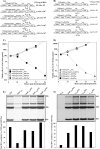
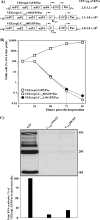
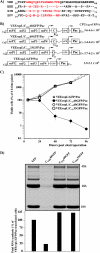


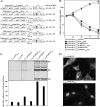
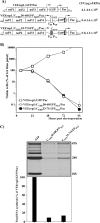
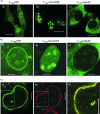
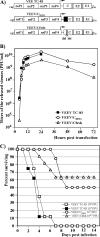
Similar articles
-
Current Understanding of the Molecular Basis of Venezuelan Equine Encephalitis Virus Pathogenesis and Vaccine Development.Viruses. 2019 Feb 18;11(2):164. doi: 10.3390/v11020164. Viruses. 2019. PMID: 30781656 Free PMC article. Review.
-
Interplay of acute and persistent infections caused by Venezuelan equine encephalitis virus encoding mutated capsid protein.J Virol. 2010 Oct;84(19):10004-15. doi: 10.1128/JVI.01151-10. Epub 2010 Jul 28. J Virol. 2010. PMID: 20668087 Free PMC article.
-
The Old World and New World alphaviruses use different virus-specific proteins for induction of transcriptional shutoff.J Virol. 2007 Mar;81(5):2472-84. doi: 10.1128/JVI.02073-06. Epub 2006 Nov 15. J Virol. 2007. PMID: 17108023 Free PMC article.
-
Venezuelan equine encephalitis virus capsid protein inhibits nuclear import in Mammalian but not in mosquito cells.J Virol. 2008 Apr;82(8):4028-41. doi: 10.1128/JVI.02330-07. Epub 2008 Feb 6. J Virol. 2008. PMID: 18256144 Free PMC article.
-
Venezuelan Equine Encephalitis Virus Capsid-The Clever Caper.Viruses. 2017 Sep 29;9(10):279. doi: 10.3390/v9100279. Viruses. 2017. PMID: 28961161 Free PMC article. Review.
Cited by
-
Current Understanding of the Molecular Basis of Venezuelan Equine Encephalitis Virus Pathogenesis and Vaccine Development.Viruses. 2019 Feb 18;11(2):164. doi: 10.3390/v11020164. Viruses. 2019. PMID: 30781656 Free PMC article. Review.
-
Antibody Preparations from Human Transchromosomic Cows Exhibit Prophylactic and Therapeutic Efficacy against Venezuelan Equine Encephalitis Virus.J Virol. 2017 Jun 26;91(14):e00226-17. doi: 10.1128/JVI.00226-17. Print 2017 Jul 15. J Virol. 2017. PMID: 28468884 Free PMC article.
-
Conservation of a packaging signal and the viral genome RNA packaging mechanism in alphavirus evolution.J Virol. 2011 Aug;85(16):8022-36. doi: 10.1128/JVI.00644-11. Epub 2011 Jun 15. J Virol. 2011. PMID: 21680508 Free PMC article.
-
Venezuelan equine encephalitis virus nsP2 protein regulates packaging of the viral genome into infectious virions.J Virol. 2013 Apr;87(8):4202-13. doi: 10.1128/JVI.03142-12. Epub 2013 Jan 30. J Virol. 2013. PMID: 23365438 Free PMC article.
-
The amino-terminal domain of alphavirus capsid protein is dispensable for viral particle assembly but regulates RNA encapsidation through cooperative functions of its subdomains.J Virol. 2013 Nov;87(22):12003-19. doi: 10.1128/JVI.01960-13. Epub 2013 Sep 4. J Virol. 2013. PMID: 24006447 Free PMC article.
References
-
- Alevizatos, A. C., R. W. McKinney, and R. D. Feigin. 1967. Live, attenuated Venezuelan equine encephalomyelitis virus vaccine. I. Clinical effects in man. Am. J. Trop. Med. Hyg. 16:762-768. - PubMed
-
- Berge, T. O., I. S. Banks, and W. D. Tigertt. 1961. Attenuation of Venezuelan equine encephalomyelitis virus by in vitro cultivation in guinea pig heart cells. Am. J. Hyg. 73:209-218.
Publication types
MeSH terms
Substances
Grants and funding
LinkOut - more resources
Full Text Sources
Other Literature Sources
Molecular Biology Databases

